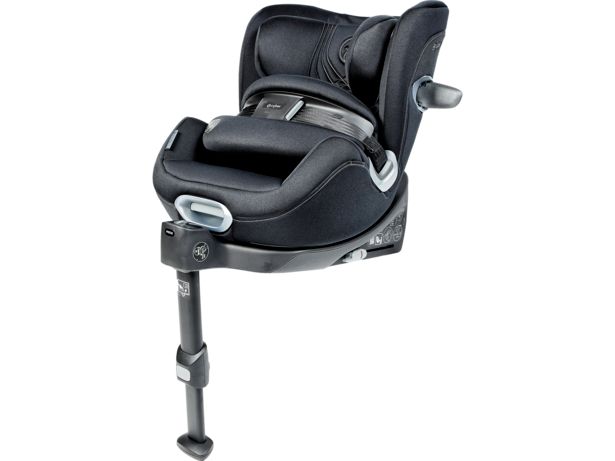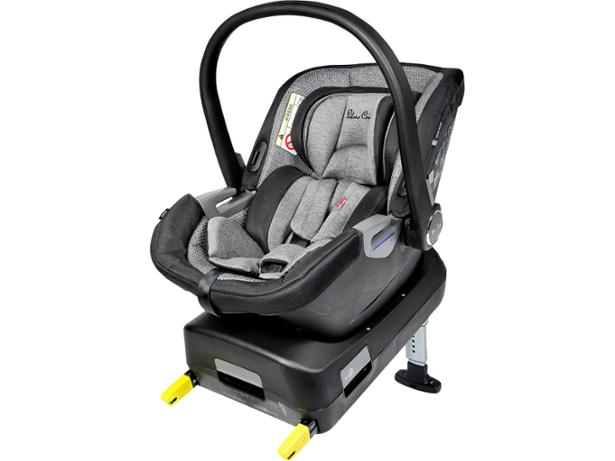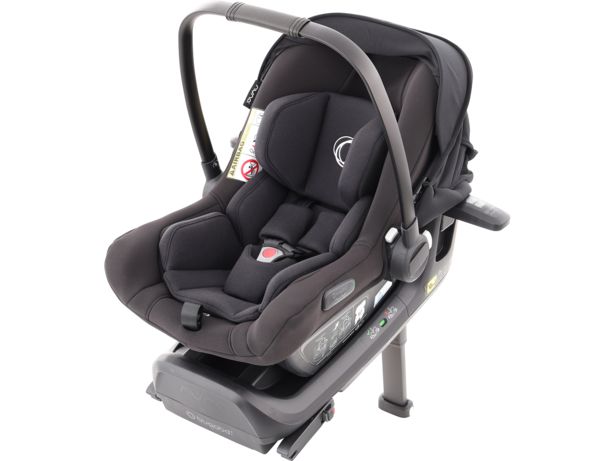By clicking a retailer link you consent to third-party cookies that track your onward journey. If you make a purchase, Which? will receive an affiliate commission, which supports our mission to be the UK's consumer champion.
How we test baby and child car seats

In this article
- Video: How we test child car seats
- How the seat withstands different crashes
- Ease of installation
- How comfortable it is for your child
- What do star ratings and % scores mean and how are they calculated?
- How the overall car seat test score is calculated
- Why are some labelled Best Buy and some Don't Buy?
- Why do you rate some extended rear-facing seats as Don't Buys if they're supposed to be safer?
Only Which? child car seat reviews combine safety, comfort and ease of use tests, to help you get the best baby or child car seat.
Our crash tests go above and beyond the standard so you can be sure you're choosing the safest seat for your child.
Keep scrolling for more information on our robust testing or head straight to our round-up of the best baby and child car seats for our top recommendations.
Video: How we test child car seats
Our video below shows you some of the safety failures we've found while testing car seats. These include children being flung forward and seats breaking.
Unlike some other websites that publish reviews, we crash-test each child car seat we test and carry out fitting checks so we can tell you which give the best protection and which you should avoid. Here's why you can trust our testing.
How the seat withstands different crashes
Our experts have specially designed our baby and child car seat crash tests, making them more demanding than the British standard safety tests.
They’re derived from tests by Euro NCAP. This is the organisation that carries out crash testing on cars to show how well they protect occupants in severe accidents.
We feel our tests more accurately reflect what could happen in a real crash than the British standard safety tests.
Each car seat we test endures:
- A front crash, equivalent to a head-on collision at around 40mph
- A side crash, equivalent to two cars crashing into each other at 30mph.
These are repeated again and again, with the seat installed in all the different ways it can be used.
We can go through as many as 15 samples of the same seat to get the final score for just one.
If a car seat can be used in a number of different ways (for example, if it’s a multi-group car seat that spans different stages) or attached by different methods (Isofix or car’s seatbelt), we crash-test it in the different ways it can be used and these results all feed into the overall safety score.
Crash test dummies are wired up with state-of-the-art sensors to record the crash forces on the most vulnerable parts of the body, to help accurately indicate the risk of injury to a real baby or child in a crash.
The overall safety rating also takes into account the stability of the car seat in the car in case it seems loose or rickety, and how easy it is to thread the car’s adult seat belt around the car seat if this is an option.
Ease of installation
It’s vital to ensure your car seat is fitted correctly. Any car seat, even a Best Buy, would be rendered unsafe if it’s installed incorrectly.
Ease-of-use tests are not part of the legal requirements, but we conduct a whole range of tests on each seat to make sure that parents can fit them properly, without any risk of getting it wrong.
Parents get hands-on with the car seats to try to install them. These hands-on assessments give our experts an indication of the risks of installing a seat incorrectly, what could be forgotten, or how the seat could be misused.
We fit each seat in three different makes and models of car to see how easy it is to install. Experts consider both Isofix and seatbelt modes.
We scrutinise instructions and warning labels to see whether there is anything confusing, annoying or misleading.
Real children of different ages try out each seat, in all the cars. This helps to highlight any safety issues or problems with using the seat on a day-to-day basis – something our dummies can't tell us.
We also consider how easy the car seat cover might be to clean based on whether you can remove it easily and how it can be washed, and whether the seat has any signs of shoddy workmanship.
Our reviews point out potential issues you'll need to check before selecting your car seat, such as underfloor storage compartments or car headrests that could stop your seat working properly.
If a car seat is particularly heavy, we'll let you know in our review, so you can weigh up this information before you buy your car seat.
How comfortable it is for your child
Our car seat testing includes an ergonomic assessment of each seat to make sure your child will be in the best position when travelling. Any seats that hold your baby too upright, especially baby car seats, will have points deducted.
Our car seat experts check to make sure your baby or child will be held in a good position while travelling, which is especially important for small babies.
Experts check how roomy the seat is for your child and how much space they'll have to grow, as well as how the head support padding works.
The amount of space a car seat takes up is important too. If it takes up too much, there may be none left over to safely transport other children, or it could impact space for the passenger in the front seat.
We look at the comfort for the child, including how much support there is for the child's legs, the padding and their view from the seat, as you don't want children tempted to lean forwards out of their seat.

What do star ratings and % scores mean and how are they calculated?
At the end of all of these tests, each child car seat will have been awarded a number of star ratings, one for each of the tests.
The stars range from one to five:
- 5 stars = excellent
- 4 stars = good
- 3 stars = satisfactory or average
- 2 stars = poor
- 1 star = very poor
You can see these star ratings on each child car seat’s Test Results page, so you can quickly work out which car seat is best for you based on what’s most important to you.
From these star ratings we calculate one overall final score for each child car seat. This is shown as a percentage to make it easiest to understand and compare between different seats.
How the overall car seat test score is calculated
All child car seats are tested in the same way, regardless of the manufacturers’ claims, so you can compare any baby or child car seat at any price and know how it measures up against its rivals in key areas.
The most important things – such as how well the car seat performs in front and side impact collisions, will more greatly impact a car seat’s score than whether or not the harness buckle is a bit fiddly.
Which? does not rate a car seat on the colour or pattern of the car seat cover.
Here’s a breakdown of how the overall car seat test score is calculated:
- Safety 60%
- Ease of use 30%
- Ergonomic assessment 10%
Why are some labelled Best Buy and some Don't Buy?
Best Buy car seats tick the most important boxes – good or excellent safety scores, an easy installation process, and well-designed ergonomics and comfort.
As of May 2023, the percentage score car seats need to achieve to be named a Which? Best Buy are as follows:
- 78% or more for a baby car seat (i-Size baby or Group 0 or 0+)
- 71% or more for a toddler car seats (i-Size baby to toddler, i-size toddler, i-Size toddler to child, group 1 or group +0/1)
- 74% or more for a child car seat (i-Size child or group 2/3)
- 71% or more for a multi-group car seat (i-Size baby to child or Group 1/2/3 or any combinations of these groups).
The percentage score car seats need to achieve to be named a Which? Best Buy differs for different types of car seat because each has its own set of pros and cons that can bump up a score.
For example, baby car seats typically have more safety features and this can bump up their scores.
It's all calculated scientifically to make sure every seat is judged equally and fairly.
Any model that scores 45% of less will be named a Which? Don’t Buy car seat.
Car seats rated 0% have performed so badly in our crash tests that we will automatically downgrade the total test score to the lowest possible rating and they automatically become safety Don't Buys.
This can be because the car seat is not up to withstanding the forces of a crash in a particular setup.
Or because part of the seat breaks or detaches during the crash tests. A good result in any other part of our tests cannot compensate for such a poor result.
Our child car seat reviews, just like other Which? reviews, are for Which? members but any car seats named Don't Buys are given a safety alert that's free for anyone to read as we believe it's our public duty to inform all parents about any serious hazards or risks our tests have uncovered.
Why do you rate some extended rear-facing seats as Don't Buys if they're supposed to be safer?
Rearward facing is the safest way for babies and young children to travel in a car. We encourage all parents to keep their children rear facing for as long as possible. Ideally until your child turns four years old.
But child car seats can become Don’t Buys even if the crash test scores are good. That's because they are extremely difficult or overcomplicated to fit into your car.
An incorrectly fitted car seat is much less likely to adequately protect your baby or child in a collision with another car.
Go to our best extended rear-facing baby car seats guide to find out which come top in our crash tests.
Do you score car seats based on the colour or pattern of the car seat cover?
No. We would never judge a car seat based on its colour or pattern. We don't care if the seat is black, red, blue or covered in flowers, so long as it's safe enough to protect a child in a crash.
As mentioned earlier in this article, the test score is made up of safety, ease of use, and an ergonomic assessment.
Why don't you recommend backless booster seats or test more of them?
Backless booster seats have no headrest or side wings, which means they offer very little protection in a crash – particularly if you’re hit from the side.
A backless booster seat can also make it tricky to correctly position the diagonal strap of the three-point adult seat belt across your child’s shoulder.
This could result in the seat belt digging into your child’s body and causing injury, and it won’t properly prevent your child from slamming into the side of the car interior.
We have put one backless booster seat through our tests in the past few years, the MiFold Grab and Go. It rated poorly in our crash tests and is a Don’t Buy.
Instead of testing seats we know will fail, we choose to put the thousands of pounds it costs us to test each baby and child car seat towards helping parents make smarter buying decisions about those seats that should be able to pass our tests.
With this in mind we crash-test and review a number of high-back booster seats (Group 2/3), which are typically used with children aged between four and 12.
Find out more about booster seat law and which are safest in our tests in our guide to the best booster seats for children.
How do you choose what speed you crash-test at?
Our crash tests are severe and our experts feel that they more accurately reflect what happens in real crashes than the legal minimum regulation that manufacturers are required to adhere to in order to sell their products.
The minimum regulations are currently:
- Any baby or child car seat that has ECE R44/04 on the label must have been through a frontal-impact crash test at 32mph, a rear impact at 18mph and a roll-over simulation test. There is no mandatory side-impact test.
- Any baby or child car seat with R129 on the label has been tested to a new regulation (also known as i-Size), and they undergo the same tests as ECE R44/04, with the addition of a side impact test at 15mph.
Each car seat we test, no matter what regulation it claims to adhere, goes through:
- A front crash, equivalent to a head-on collision at around 40mph
- A side crash, equivalent to two cars crashing into each other at 30mph
Every car seat goes through the same tests in our labs using state-of-the-art crash-test dummies and sensors, so you can directly compare car seats strengths and weaknesses in our reviews.
The results of our faster-than-the-regulations crash tests reveal big differences between car seats. Some protect babies and children well, but others expose them to the risk of serious injury or even death.
We are sometimes asked why we don't crash-test car seats at 70mph.
A crash at this speed would most likely overload the vehicle structure, so the effectiveness of any safety features such as seat belts, airbags and child car seats would be severely compromised.
With our crash tests we aim to find a severe enough impact that covers a large proportion of the fatal and seriously injured accidents we see, so we can make the most significant difference possible.

Where are your tests carried out?
Which? started testing child car seats in 1967 and since 2003 we’ve been crash-testing them as part of a European test consortium along with the International Consumer Research & Testing (ICRT) and the European car clubs.
We carry out tests at laboratories around the world that are experts in their field of testing and we choose as many widely available and popular products to test as practicable.
Fifty years of car seat testing
Which? has been helping to keep children safer in cars for more than 50 years. In 1966, almost 8,000 people were killed in road accidents in the UK. There was a huge push for better road safety, and the following year the motorway speed limit was fixed at 70mph, the breathalyser was introduced and the first Which? child car seat reviews were published.
We constantly review the tests we carry out on car seats for babies, toddlers and children, and update them as required to keep them as thorough as possible.
In 2011 we changed the car body we use for testing to more accurately reflect the current seatbelt layout and design of a typical family car.
In 2015, following the introduction of r129 car seat regulations (which run alongside r44.04), we revised our testing procedures and assessments again to those detailed on this page.
This means you should be aware of the date tested when you read each review, and avoid direct comparisons between pre-2015 reviews and those since.
Watch our video below to see how things have changed between then and now, and see how our crash tests discover the best child car seats.
As well as being at the forefront of independent safety testing of child car seats, Which? has campaigned for decades to help families travel more safely in their cars. We’ve helped usher in stricter seatbelt laws, and raise the standard for child car seat testing in the UK.
Join Which? to access all our in-depth child car seat reviews. Already a member? Log in to find your new car seat.



